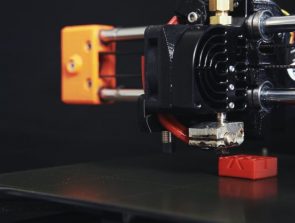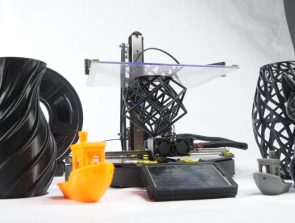10 Best Resin Printers of 2019
Welcome to our no-nonsense 3D printer guide. Here we walk you through the best SLA/DLP printers available in 2017. Although there are fewer choices compared to FDM printers, the options are still impressive. Below we list value-for-money printers that deliver high-quality results.
So who are these reviews for? This guide was written to help beginners and advanced users alike. Don’t worry if you are new to the world of 3D printing. You’re not going to find unnecessary jargon or overly technical details on this page.
Why Resin Printers?
Why choose SLA/DLP over a FDM (Fused Deposition Modeling) printer? That’s a good question. Fortunately deciding between the two is easy once you know the pros and cons of each technology. We’re going to simplify things so that you have a clearer understanding of your options.
FDM printers are more popular than SLA and DLP. That doesn’t mean FDM printing technology is better. It just means they sell more machines. You’ll see why in a moment. The sales gap between them has begun to narrow recently.
Quick Pros and Cons
The reasons below explain why FDM 3D printing is the most popular choice to date. But be sure to read past the comparisons to find out why SLA/DLP might still be your best choice.
FDM printers are the most popular choice because:
SLA 3D printers are, by comparison:
Based on the above it might seem like a no-brainer to choose an FDM model. Not so fast, there’s something else you need to know about SLA and DLP printers.
Quality is often the most important factor with 3D printing. The overall quality of finish you get with a resin printer is considerably better than that produced with FDM technology. If quality is your top priority then you’ll want to stay on this page and read the reviews for our top SLA printers.
If you want to learn more about 3D printing technology, we have a guide on the different types of 3D printers.
Visit this page to see the best FDM printers.
SLA & DLP VS. FDM
You will see the terms SLA and DLP throughout this guide. We refer to laser-based StereoLithoGraphy simply as SLA, and Digital Light Processing as DLP.
FDM (Fused Deposition Modeling) printers print using pliable thermoplastics. When heated, thermoplastics take on a molten form and return to a hardened state once cooled.
SLA and DLP printers use a curable photopolymer material, which is a liquid resin. That’s why you’ll often see them referred to as ‘resin printers’ collectively
As you can see FDM printers start with a solid material while SLA/DLP printers use liquids. All 3D printers operate the same way by building their parts layer by layer.
SLA is an older and slower technology than DLP. SLA uses an ultraviolet laser and mirrors to cure the resin. DLP uses a projector to cure large areas of resin. Although DLP is better than SLA, both technologies produce superior prints than FDM printers.
How We Chose Our Top SLA 3D Printers
The way we select our best picks of SLA 3D printer is contingent on the following conditions:
- Personal, hands-on reviews
- Consumer reviews
- Opinions of experts
We will update the guides when necessary to keep pace with changes.
Ok, let’s now take a look at the top 10 resin printers. We include all the pros and any cons, along with the printer’s overall capabilities. We also include the most important tech features of each model.
The Price Range
You generally get better quality the more you pay. Resin printers are no exception. Since not everyone needs all of the latest and greatest features, we have sorted this guide by price to make it easier to find a printer.
Choose Your Budget:
SLA/DLP 3D Printers Under $3,000
A few years ago it would have been impossible to find resin printers under $3000. Today, more options are becoming available to consumers. This is in large part thanks to crowd-funded models.
1. XYZPrinting Nobel 1.0A
Editor’s Rating: 4.5/5.0
The XYZ Printing Nobel 1.0A is a great resin (SLA) printer. It’s an upgrade on the previous model, the Nobel 1.0. Major improvements include better printing performance and improved accuracy. It also boasts higher resolutions and it has an enhanced laser.
Although this printer is not cheap, it is cheaper than the Formlabs Form 2. That means it’s going to fall short in some areas. The Nobel 1.0A XYZPrinting 3D printer is a good deal for the money though.
Who is the XYZprinting Nobel 1.0a SLA 3D Printer for?
This is a great choice of 3D printer for professionals, solopreneurs, and hobbyists. It’s especially useful for anyone who needs versatility in their 3D projects. For example, you can print using a range of various materials. This includes castable resin, flexible resin, and a choice of multi-colored acrylic resins.
Jewelers, designers, and architects can all get good use of this printer’s versatility. It is one of the more affordable high-performance 3D printers available today.
How easy is this printer to use?
There’s a lot of smart integration with this 3D printer by XYZPrinting. It comes equipped with plenty of hassle-free operations at your fingertips.
The Nobel 1.0A monitors the entire printing process for you. It lets you know how much resin remains at any given time. It has resin-filling functions too. That means no manual interference is necessary. In other words, the printer works out optimized laser parameters so you don’t have to.
The XYZware Nobel software is smart and reliable. During the printing process, it automatically analyzes the unique features of the 3D model. It then adds the right amount of support structure to the proper place at the exact time necessary. This helps to produce the best possible end product.
Anyone, at any level is able to achieve superior printed parts at an affordable cost thanks to these features.
What are the key attractions of the Nobel 1.0A?
This is a plug-n-play 3D printer with a USB port. One of the key attractions is that you can simply insert a USB drive and then press the ‘PRINT’ button. Another attraction of the Nobel 1.0A is that it gives you high-resolution printing at a reasonable cost. The auto-refill feature and other hassle-free operations are all good selling points.
| Tech Specs |
|---|
| Technology: SLA |
| Build Size: 128x128x200mm |
| Resolution: 130 Micron |
| Dimensions: 280x337x590mm |
| Connectivity: USB 2.0 |
| File Format: .stl, .3w |
| OS: PC only, Windows 7 and above |
| The Pros |
|---|
| High-quality prints |
| Easy to use |
| Autofill resin option |
| The Cons |
|---|
| None |
2. Formlabs Form 1+
Editor’s Rating: 4.4/5.0
Next up is the Form 1+ by Formlabs. This is an older model and a more affordable option than the Formlabs Form 2. There are still plenty of these machines around for sale.
The Form 1+ is a very capable printer. The prints it produces have excellent detail. Since the launch of the first Form 1, the 1+ enjoyed some notable upgrades. For instance, a faster and more powerful laser was a welcome change.
The Form 1+ is a consistent printer that users can print high-quality parts with time and again. This is a fairly compact and quiet machine, which is something home users appreciate.
Who is the Form 1+ 3D printer for?
The Form 1+ is an affordable 3D printer compared to some of the others mentioned in these reviews.
This is a printer geared towards professionals and prosumers. It’s a good choice for product designers and engineers who need a reliable and tried-and tested machine. We don’t recommend this model for entry-level users just getting started because it’s not the easiest printer to set up and use.
Novices, schools, and hobbyists might want to focus their attention more toward the Ultimaker 2. We suggest you skip this review if you’re the type of person who doesn’t like to tinker much. For everyone else, keep reading because this could be the printer you’ve been looking for. After all, it’s been a good seller for a reason.
How easy is this printer to use?
If you’re familiar with 3D printing then setting up and using the Form 1+ will not be a problem. For everyone else, it could prove fiddly. There’s quite a steep learning curve with this machine.
It’s vital to read all the instructions that come with it. You need to know how to keep the resin tank clean. Additionally, you will need to keep the mirrors free from dust. You’ll need to understand the importance of the printing angle, and the correct location of parts on the tray.
Missing out on a few minor details will have a negative impact on the finished part. If you do get stuck there is a large community to support the Form1+.
What are the key attractions of the Form 1+?
Despite the fact that a lot of people look to the Form 2 nowadays, there’re still plenty of good reasons to consider the Form 1+. The price will be a key attraction for many. Another important appeal is the easy-to-use software, which sets up the supports necessary to print. The excellent support surrounding this machine – should you need it – is second to none.
| Tech Specs |
|---|
| Technology: SLA/DLP |
| Build Size: 12.5×12.5×16.5cm |
| 3rd Party Material: No |
| Open source: No |
| Connectivity: USB |
| Min height: 25 microns |
| Max height: 100 microns |
| The Pros |
|---|
| Print quality |
| Build quality |
| Precision printing |
| Easy-to-use software |
| The Cons |
|---|
| Arduous prep and finishing |
| Limited color choices |
| Material availability |
| Running costs |
| Speed |
SLA/DLP 3D Printers Between $3000 – $5000
Most resin printers are in this price range. You can get a good bang with your buck at this price. The Morpheus is the most promising printer, but since it’s still launching there is a lot that is unknown performance wise.
3. Formlabs Form 2
Editor’s Rating: 4.9/5.0
Anyone who knows anything about 3D printers will know of FormLabs. They are a prominent manufacturer of stereolithography machines.
The Form 2 is the company’s third generation printer and it comes with some impressive upgrades. This desktop printer has wireless connectivity which pleases a lot of users. There’s a new peeling feature, a smart automated resin system, and a heated tank. The touchscreen display is another nice touch. These reasons all contribute toward the popularity of the Formlabs Form 2.
For most users the only thing that matters is quality. Without that, none of these bells and whistles would mean a thing. The Formlabs Form 2 doesn’t disappoint. It’s fair to say that the 3D printouts produced by this printer are the highest quality of any desktop 3D printer today.
As you can see, there’s a lot to like about the Formlabs Form 2.
Who is the Formlabs Form 2 printer for?
This 3D printer is a perfect choice for professionals and serious home users who are creative and passionate about quality. It does come with a hefty price tag. This means it’s not suitable as an entry-level machine for someone with a casual interest in 3D printing. It’s also a good choice for people who just want to get on printing without too much fiddling.
How easy is this printer to use?
You can pretty much be up and running with this machine right out of the box. All you have to do is install the print bed, slide in the resin tank, plug it in, and then connect to a USB drive or network. That’s about it.
The PreForm software is self-explanatory and provides you with a few simple operations such as shifting and scaling. The touchscreen display is easy-to-use amd intuitive. Even a novice can start printing with the Formlabs Form 2 in no time.
What are the key attractions?
There are many key attractions of the Formlabs Form 2. At the top is the printer’s ease-of-use, high-quality 3D printed parts and brand-worthy recognition. This is a machine that is consistently reliable in the performance department. It produces 3D objects that are as detailed and as complex as you need them to be. Another of its attractions is that it supports both network and USB printing.
| Tech Specs |
|---|
| Technology: SLA/DLP |
| Build Size: 14.5×14.5×17.5cm |
| 3rd Party Material: Yes |
| Open source: No |
| Connectivity: USB/WiFi |
| Min height: 25 microns |
| Max height: 100 microns |
| Heated Platform: Yes |
| The Pros |
|---|
| Exceptional print quality |
| Outstanding build quality |
| Smooth touchscreen operation |
| Quiet printing |
| Wireless print uploading |
| The Cons |
|---|
| Somewhat messy |
| Operational costs |
| Speed |
4. FlashForge Hunter DLP
Editor’s Rating: 4.7/5.0
FlashForge has become an industry leader in affordable desktop 3D printers. You’ll love this machine if you like to observe the 3D printing process. It has a smart translucent UV-protective cover which allows you to watch the entire process from start to end.
The FlashForge Hunter lets you use third-party resin. This is great news for users who need more flexibility and choices in materials. For example, you can print using castable and biocompatible resin to name a couple.
Who is the FlashForge Hunter DLP 3D printer for?
The FlashForge Hunter DLP 3D Printer is a great machine for producing detailed engineering prototypes. It’s also useful for printing medical models.
This is a smart and reliable printer for the committed hobbyist who wants to make some money 3D printing parts for others. It works well for certain industries like jewelry, design, dentistry, and rapid prototyping.
How easy is this FlashForge 3D DLP printer to use?
There’s nothing complicated with the FlashForge 3D DLP for those who are familiar with 3D printing. The improved resin box on this machine allows for rapid removal and quick resin changes. There’s also an alarm added which alerts the users once the resin has been exhausted.
What are the key attractions for this 3D printer?
The price of the FlashForge Hunter is a major plus. Although it’s not cheap, it’s still cheaper than a lot of the competition.
This is a quiet printer. Some may argue that it’s too quiet. It prints high-quality 3D parts, which is a major plus with all users. The semitransparent UV-protective cover is novel like Dyson’s transparent vacuum cleaners were back in the day. People marvel over the workings of machines, and the FlashForge lets you monitor the entire printing progress.
| Tech Specs |
|---|
| Technology: DLP |
| Build Size: 120×67.5×150mm |
| Printer Size: 360x310x565mm |
| Z height: 25/50µm |
| X-Y height: 62.5µm |
| Light Source: 405nm LED |
| File Format: File Format |
| The Pros |
|---|
| Reliable and consistent |
| High-quality 3D parts |
| WiFi and USB connectivity |
| Protective translucent cover |
| Uses third-party resins |
| Quick and easy to remove finished parts |
| The Cons |
|---|
| Too quiet: You won’t know whether it’s printing unless you check |
5. 3D Systems ProJet 1200
Editor’s Rating: 4.6/5.0
Our third best pick is 3D System’s all-in-one Desktop ProJet 1200. This is a neat, compact, feature-rich 3D printer that has a lot to offer. It’s ideal for printing small, strong parts that are precise and detailed. It’s an excellent choice for 3D printing accurate prototypes, jewelry designs, and figurines. This is a high-cost 3D printer for most hobbyists. However, for professionals, this is an incredibly affordable and capable printer.
Who is the ProJet 1200 Micro-SLA printer for?
This printer is ideally suited for professional use. It’s a particularly good choice for dental technicians, engineers, and jewelers. It’s useful for people or companies who need to cast 3D parts to metal. It’s also a great 3D machine for anyone who doesn’t have space for something bigger. The all-in-one Desktop ProJet 1200 is smaller than the average coffee maker.
How easy is this printer to use?
There isn’t a steep learning curve to this printer. It has a track record of reliability. This is a fairly silent machine as well. It’s economical to operate, safe to put anywhere, and simple to use.
The printer’s all-in-one cartridges are hassle-free. They’re also waste-free as excess materials can be reused in the next print.
The ProJet 1200 is portable and it is easy to carry around and use wherever you need it to be. As it’s a network-based printer, you can work outside, in the garage, or indoors – it’s really up to you.
What are the key attractions for the 3D Systems ProJet 1200?
The key attractions for the 3D Systems ProJet 1200 3D machine are easy to sum up. The printer’s ability to produce small, precise and very detail-rich 3D parts is a major attraction. Then there’s its portability, simplicity, and small size. Fast printing and ultra-hi-rez parts are high up there on the list of key features too. People also like the fact that it’s super-quiet. It ticks a lot of the right boxes for professionals who need exactly what the ProJet 1200 has to offer.
| Tech Specs |
|---|
| Technology: SLA/DLP |
| Build Size: 4.29×14.99×2.69cm |
| Min heigh: 30 microns |
| Connectivity: Ethernet |
| The Pros |
|---|
| Exceptional print quality |
| Superb build quality |
| High precision |
| Low noise level |
| Portability |
| The Cons |
|---|
| Material availability |
| Running costs |
| Price |
6. Morpheus
Editor’s Rating: 4.0/5.0
Meet the Morpheus 3D Printer, yet another successfully funded Kickstarter project. The mission was to create a 3D machine that could make printing parts bigger, easier, and faster. No one could disagree with that, but have the team achieved their goals?
Yes, it looks as though they have. What’s so special about this printer is that the designers left out any parts and functions deemed unnecessary. They’ve done this as a way to create simplicity of use and to improve productivity. This has allowed for a larger build volume that fits comfortably into a small unit.
Morpheus doesn’t utilize traditional technologies, namely SLA and DLP. It uses something that is simpler and better. They call this Light Induced Planar Solidification or LIPS for short. LIPS technology also lets the Morpheus 3D Printer create larger parts easier and somewhat faster. That’s a lot of great boxes to check. It’s why experts call it the ‘Cutting-Edge Morpheus LIPS 3D Printer.’
Who is the Morpheus 3D Printer for?
The Morpheus 3D Printer is a perfect choice for the serious hobbyist, prosumer, entrepreneur, or small office. It’s a great machine for those who want the technology with the least amount of learning and tinkering possible. That makes it an interesting choice for a lot of people.
How easy is this printer to use?
Producing 3D parts doesn’t get much simpler than the Morpheus 3D Printer. The start to end operation is easy to grasp and simple to execute. For example, there’s no calibration or leveling to worry about. Nor are there any software and hardware settings to mess around with. These are all things that result in a hassle-free printing experience.
Once you have your 3D model (computerized file) you just prepare it in the free and self-explanatory slicing software program. The only thing remaining is to press the ‘PRINT’ button and let the Morpheus work its magic.
What are the key attractions of the Morpheus 3D Printer?
The key attraction for the Morpheus 3D Printer is that it’s something new and exciting. It pushes the boundaries and gives the user more for less. Most users don’t want to tinker and spend time with settings, adjustments, and fine-tuning. With this innovative 3D machine you don’t have to.
It lives up to its promises and lets you print larger parts quickly and easily. If a hassle-free printing experience is a top priority, then you’ll definitely want the Morpheus on your shortlist of options.
| Tech Specs |
|---|
| Technology: LIPS |
| Manufacturer: Owl Works |
| Min height: 0.025 mm |
| Max size: 330x180x300mm |
| The Pros |
|---|
| Value for money |
| Print quality |
| Print speed |
| LIPS technology |
| Prints multiple parts at once |
| The Cons |
|---|
| None |
7. B9 Creator v1.2
Editor’s Rating: 3.9/5.0
The B9 Creator was one of the first resin printers targeted at consumers. You can find it in either kit form or assembled – the latter obviously costing more. This is another Kickstarter success stories and continues to be a popular model with each upgrade.
This 3D machine uses DLP, or Digital Light Processing technique, to print. The current model supports three colors: black, red, and cherry. The fully-assembled B9 Creator v1.2 sports a new HD projector that boasts a brighter lamp. This allows for a fine resolution of 30 microns. The overall mechanical design has seen improvements too. This revamp helps to make assembly easier and enhances print precision.
Who is the B9 Creator 3D printer for?
This printer is popular among those who work in the jewelry, engineering, and design industries. The level of fine detail produced by this machine is comparable to 3D printers that cost a lot more. It’s not a good choice for the novice, though, as there’s a lot to learn to get optimal results.
How easy is the B9 Creator to use?
This is not an easy 3D printer to use, hence the lower rating. The B9 Creator offers a lot of great features and produces exceptional results at the cost of a steep learning curve.
The software is less than impressive and is a headache for novices. The kit form presents an even bigger challenge of course. Changing the resolution and bed leveling is an ordeal that can sap a lot of time and energy.
This is a 3D printer for those who are adept at 3D printing and enjoy the challenges associated with producing amazing parts. To be fair, those who do like working with the machine can’t get enough of it.
What are the key attractions for the B9 Creator v1.2?
The amazing resolution is obviously a key attraction of the B9 Creator v1.2. Being open source and having upgrade kits available are two more things that draw people to this very capable machine.
Right now a lot of 3D printers (that’s people, not the machines) enjoy the communities that surround the technology. The good news for anyone who buys the B9 Creator is that there’s a fantastic support community behind the product. This is the place to go for quick troubleshooting. It’s also the place to discover lots of tips on how to get the most out of your printing.
| Tech Specs |
|---|
| Technology: SLA/DLP |
| Build Size: 20.32×10.24×7.68cm |
| Min height: 5 microns |
| Open source: Yes |
| Connectivity: USB |
| 3rd party materials: Yes |
| The Pros |
|---|
| Exceptional print quality |
| High precision |
| Fast |
| Great community support |
| Value for money 3D printer |
| The Cons |
|---|
| Awkward design |
| Difficult to use |
| High running costs |
| Some reliability issues |
| Specifications |
SLA/DLP 3D Printers Over $5,000
A lot more options have popped up for high-end resin printers. Most notably, Autodesk came out with their first ever branded 3D printer.
8. Autodesk Ember
Editor’s Rating: 5.0/5.0
The Ember is an open source, professional 3D printer manufactured by Autodesk. The technology they use is DLP stereolithography. The printer has a build volume of 64x40x134 mm.
Although this printer is easy to use, you can also tinker with its settings if you need to be more creative with the designs. Autodesk is passionate about their first ever hardware project. You can see that enthusiasm in the updates and focus on usability and output quality.
What makes the Ember stand out from the pack is the technology it uses. It has a rotatable head that crystallizes a special kind of open source resin material. There are reasons why this resin is so impressive. It makes the printing process faster and with no sacrifice to quality.
Who is Autodesk’s Ember Resin 3D printer for?
Ember is a user-friendly 3D printer, capable of producing high-quality 3D parts. This means those at the entry-level can now jump in and produce professional results with little experience. It’s also a very capable printer for professional use. It’s a particularly good choice for castable component work, especially jewelry.
Despite its user-friendly appeal, the Ember’s still a little on the pricy side for all but the most enthusiastic home consumer. It’s inexpensive as a professional tool though.
How easy is the Ember 3D desktop printer to use?
Despite the advanced technology, this printer is really easy to use at any level. It’s also a machine that users can tinker with if they want or need to be more creative with their 3D parts.
What are Ember’s key attractions?
The key attraction for Autodesk’s Ember 3D printer is that it offers a new way of printing. It’s faster than other types of 3D printers but it doesn’t sacrifice quality for speed. Improved speed and high-quality are the aspirations of all 3D designers, and it looks as though Autodesk have nailed it with the Ember.
Production is another key attraction for the Ember. Thanks to the DLP technology, it’s able to print parts simultaneously, thus maximizing the user’s throughput. Finall,y this is a good looking printer too – at least in the opinion of many enthusiasts. Although appearance is not something that impacts results, aesthetics do matter to people if the printer is highly visible.
| Tech Specs |
|---|
| Technology: SLA/DLP |
| Build Size: 6.4x4x13.4cm |
| Min height: 25 microns |
| 3rd party materials: Yes |
| Connectivity: USB/WiFi/Ethernet |
| The Pros |
|---|
| Supports several third-party resins |
| Innovative 3D printing software |
| Fast and accurate |
| High-quality 3D parts |
| The Cons |
|---|
| Pricy for home users |
9. MoonRay Desktop
Editor’s Rating: 4.9/5.0
If we had to sum the MoonRay Desktop 3D Printer up in three words it would be fast, precise, and wireless. It has everything you could wish for in a decent machine. For example, it’s high quality, accurate, truly functional, and flexible. This printer is consistently durable and reliable too.
Excellent resolution and user-friendly operation makes the MoonRay a winner. It’s a big hit with both professionals and enthusiasts who need what this machine offers.
Who is SprintRay’s MoonRay 3D printer for?
The MoonRay 3D printer by SprintRay is an attractive printer for those who need a decent sized build area. It’s an ideal choice for dentists, designers, and engineers. More generally, it’s a great 3D printer for anyone who insists on fine detail, high accuracy, and an impressive surface finish.
How easy is this printer to use?
The ease of setup right out of the box is impressive. The software connects wirelessly, so even a novice can be creating detailed 3D parts in minutes. The no-fuss, durable resin tank means less maintenance and more uptime. A lot of the clutter that comes with some 3D resin printers has been stripped away to give the MoonRay a more minimalistic appeal.
What are the key attractions of the MoonRay 3D printer?
Reviewers comment on how the cool and quiet the MoonRay is. It’s certainly quieter than a lot of the competition.
From a more technical standpoint, one of MoonRay’s key features has to be the custom-built projector. This projector guarantees printing 3D parts with very fine details. The printer also boasts perfect light spectrum, allowing for 100 micron resolution.
Another of the main attractions is the long lifespan of the bulb, which lasts for 50,000 hours. That means you won’t have to replace the bulb anytime soon, if at all. Another point worth a mention is the printer’s revolutionary resin tank, which SprintRay designed to last. This is great news because it means you won’t have to mess around replacing the resin tank or have hassles changing the PDMS layer.
| Tech Specs |
|---|
| Technology: SLA/DLP |
| Build Size: 12.7×8.1×22.8 cm |
| Printer Size: 38.1×38.1×50.8cm |
| DLP Projector: UV LED 405nm |
| XY Resolution: 100 micron |
| Z Resolution: 20 micron |
| Print Speed: 25.4 mm or 1″/h |
| The Pros |
|---|
| Fast |
| Precise |
| High-resolution |
| Durable |
| Wireless |
| Reliable and consistent |
| User-friendly |
| Uncluttered |
| The Cons |
|---|
| Materials not approved for food or medical uses |
10. DWS Systems XFAB
Editor’s Rating: 4.8/5.0
This is another quality 3D printer aimed at professionals. The XFAB is by Digital Wax Systems (DWS), an Italian manufacturer with a good reputation in SLA printers.
Since the early introduction of the XFAB, there have been a number of impressive improvements by the time of its official launch. It’s a good looking printer for one. That may seem like a trivial point, but some people care about the aesthetics of a product. The latest XFAB boasts faster build speeds, along with higher resolution and surface quality. Other plusses are the intelligent cartridge system and the Nauta XFAB edition software suite.
With the XFAB comes a range of high grade materials for creative printing. These printing materials come in convenient and easy-to-use 300 ml containers.
Who is the XFAB 3D printer for?
This is a 3D printer suited to the jewelry and dental markets in particular. Having said that, people are finding it to be a great machine for a lot of other applications. It’s also a good choice for the enthusiastic hobbyist who wants to invest in a high-end 3D machine – someone we call the prosumer.
It’s a printer for those who need a broader choice of 3D printing materials than the competition can offer. This is a machine that will award users with much greater precision than most other high-end consumer 3D printers on the market. In short, the DWS XFAB stands out for its impressive print range and choices in pintable materials.
How easy is this printer to use?
The manufacturers have been on a mission to make their technology easy to use for the end user. There’s no calibration needed with the BlueEdge® laser system and zero maintenance. Thanks to DWS’s proprietary Nauta software, the simplicity of operation gets even smoother. The software even creates quick-to-remove supports using the minimum amount of material possible.
What are the key attractions of the XFAB® 3D printer?
There’s plenty to get excited about with the DWS XFAB 3D SLA printer. The large building area is certainly welcome. There’s also something called the TTT (Tank Translation Technology) system. This allows the printing of taller objects without the fear of collapse.
Having a vast range of material is something that definitely benefits some industries and prosumers. This printer also sports the highest, professional standard, surface quality. It also has fast build speeds. The well thought out software suite is a welcome feature too. Finally, the XFAB intelligent material cartridges are amazing. There’s no leakage at all, making them clean to use even without gloves.
| Tech Specs |
|---|
| Technology: SLA |
| Build Size: 180×180mm |
| Printer Size: 420x638x590mm |
| Laser: Solid State BlueEdge® BE-1300X |
| Slice thickness: 10-100 microns |
| Connectivity: USB |
| The Pros |
|---|
| Higher building speed |
| Higher resolution |
| High surface quality |
| Intelligent cartridge system |
| Nauta XFAB software suite |
| Additional material portfolio |
| The Cons |
|---|
| Price |
Closing Comments
Right now there’s a battle going on between the 3D printing technologies. Not all 3D printers and operators are equal. End users have different budgets, ideas, and expectations. There’s no such thing as the “perfect” 3D printer that suits all purposes.
There are, however, 3D machines that are perfect for some people. The way to choose a model that’s ideal for you is to understand the strengths and weaknesses of the technology. You then have to look at the individual 3D printers and see how much of what they offer meets your expectations.
SLA and DLP technology is fast becoming the choice of 3D printing for offices, schools, design shops, and research labs. Serious prosumers, entrepreneurs, designers, artists, and architects favor StereoLithoGraphy. Engineers and educators are also among those taking advantage of the latest choices in 3D resin printers.
Contents
- Why Resin Printers?
- Quick Pros and Cons
- SLA & DLP VS. FDM
- How We Chose Our Top SLA 3D Printers
- The Price Range
- Choose Your Budget:
- SLA/DLP 3D Printers Under $3,000
- 1. XYZPrinting Nobel 1.0A
- 2. Formlabs Form 1+
- SLA/DLP 3D Printers Between $3000 – $5000
- 3. Formlabs Form 2
- 4. FlashForge Hunter DLP
- 5. 3D Systems ProJet 1200
- 6. Morpheus
- 7. B9 Creator v1.2
- SLA/DLP 3D Printers Over $5,000
- 8. Autodesk Ember
- 9. MoonRay Desktop
- 10. DWS Systems XFAB
- Closing Comments


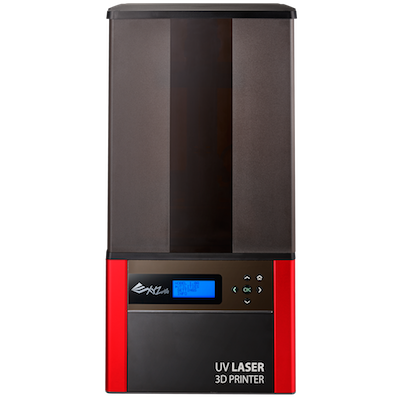 View on Amazon
View on Amazon
 View on Amazon
View on Amazon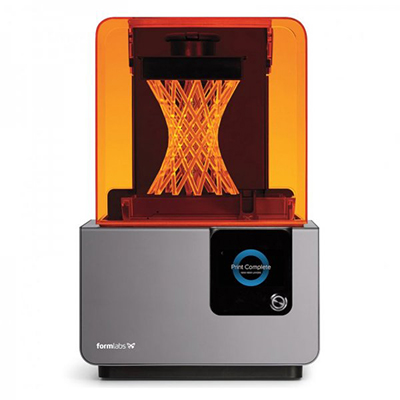 View on Amazon
View on Amazon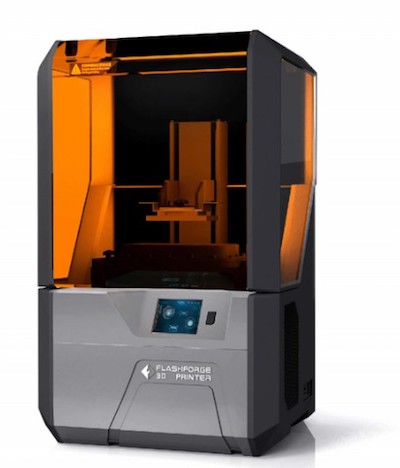 View on Amazon
View on Amazon View on Amazon
View on Amazon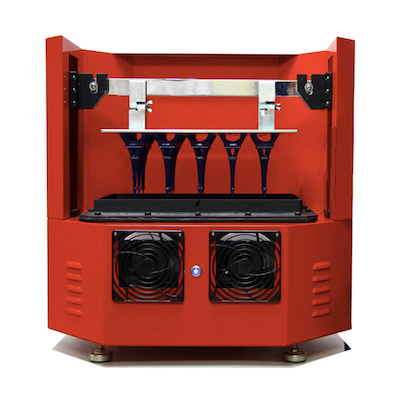 View on Amazon
View on Amazon View on Amazon
View on Amazon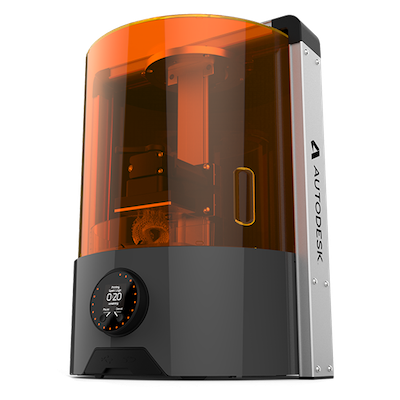 View on Amazon
View on Amazon View on Amazon
View on Amazon View on Amazon
View on Amazon